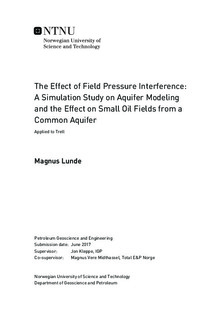| dc.description.abstract | Petroleum reservoirs do sometimes communicate through a regional aquifer. This means that a pressure drop imposed in any of the fields is transmitted across the aquifer to the other fields, and manifested as pressure interference.
If a new discovery is connected to a regional aquifer, the net off-take from nearby, producing fields may have significant impact on the water-drive mechanisms, and hence the pressure situation in the new discovery: This effect must be correctly integrated to estimate the recoverable resources for assessing development.
The objective of this study was to propose a method for integrating the effect of field pressure interference in a simulation model representing only the undeveloped discovery. Different aquifer modeling options in Eclipse have been tested.
Besides an explicit representation of the aquifer, the most common in the industry are analytic models in which the aquifer is added as a source term to the mass balance of some predefined grid cells. Although easily manageable in history matching, analytic aquifers fail to replicate successive periods of depletion and re-pressurization since the source term cannot be changed as a function of time. This is a major limitation in scenarios of pressure interference, where the production from surrounding fields, together with a strong aquifer support, may give a dynamic pressure behavior in the new discovery.
This study proposes a method using a numerical aquifer modeling solution, in which the aquifer is represented by a set of grid cells whose properties are defined independently of their actual size and position in the grid. The main advantage of this approach is that wells can be introduced in the aquifer grid cells to represent the reservoir volume off-take from nearby fields, and by that correctly model the material balance.
The proposed method is applied to Trell, which is a small oil discovery in the Central North Sea. The model is matched with the simulation results from a regional, explicit model covering Trell and surrounding Paleocene and Eocene fields in the Frigg-Heimdal area. The final results show a good match of pressure evolution and cumulative water inflow. | |

